China is home to nearly a quarter of the world’s population age 60 or older, which is projected to double over the next two decades. The country is growing old before it gets rich. The fast aging of the population is coupled with simultaneous change in the family structure, as a result of one-child policy adopted in late 1970s, as well as rapidly growing urbanization and migration. These unique circumstances are driving a need for the country to enhance its social infrastructure and to develop new models to accommodate a healthy, productive, and active aging population.
The Chinese government has responded to the demographic transformation with policies to support older adults’ independent living and social engagement. With the most aged population among developing countries in this study, China is also a leader on increasing access to long-term care and improving the quality of healthcare for older adults. As the economy slows down and shifts toward a more consumption-driven growth model, the government is eagerly seeking to turn the service sector for older adults into a new growth engine and to integrate digital technologies with new products and solutions for older adults.
The government has failed to capitalize on the productive opportunity resident in the older population. Although older Chinese are relatively more active in the workforce than counterparts in industrialized countries, largely driven by financial need, they receive little government support or legal protection.
Number and Share of Population Age 60 or Older
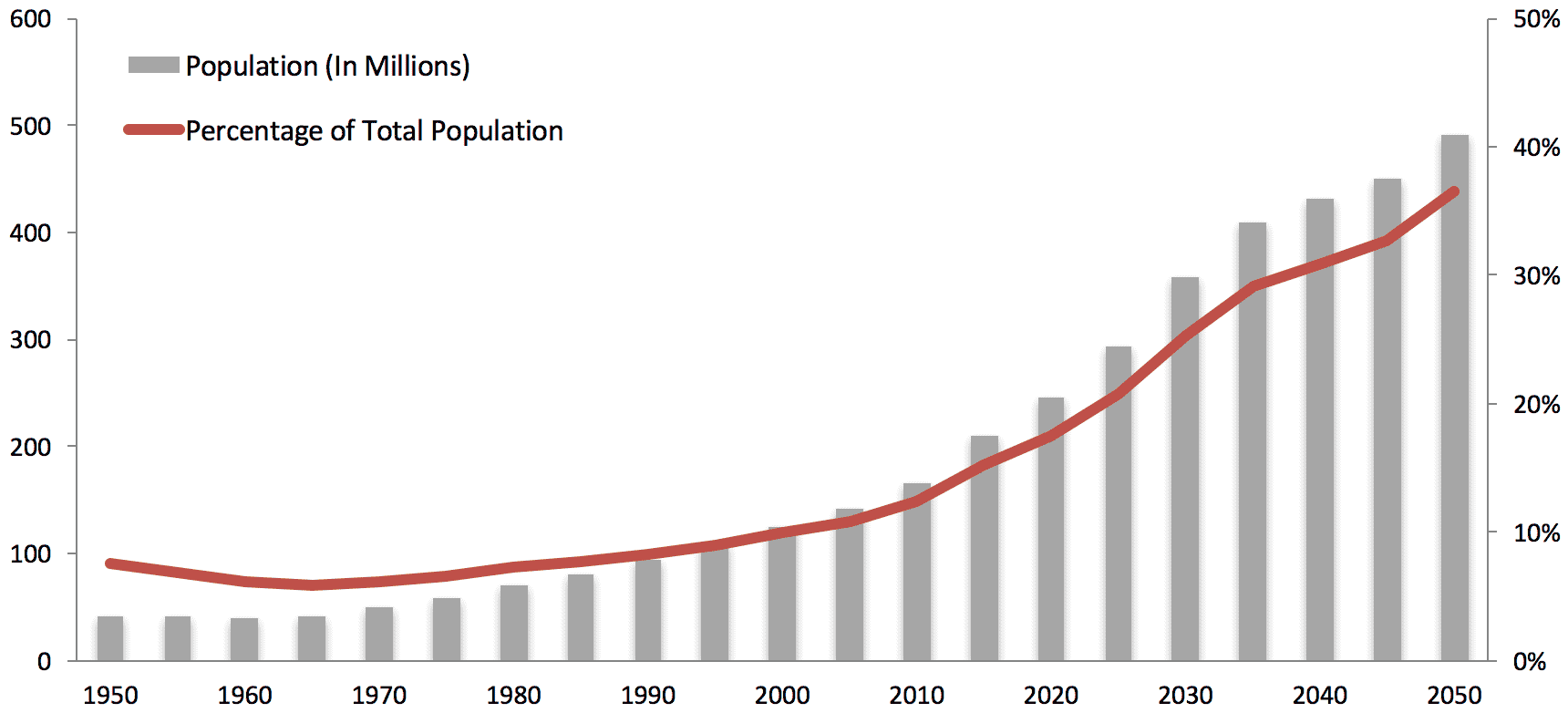
China’s population age 60 or older had reached 210 million as of 2014, as large as the populations of Germany, the United Kingdom, and France combined.
Source: UN Population Division
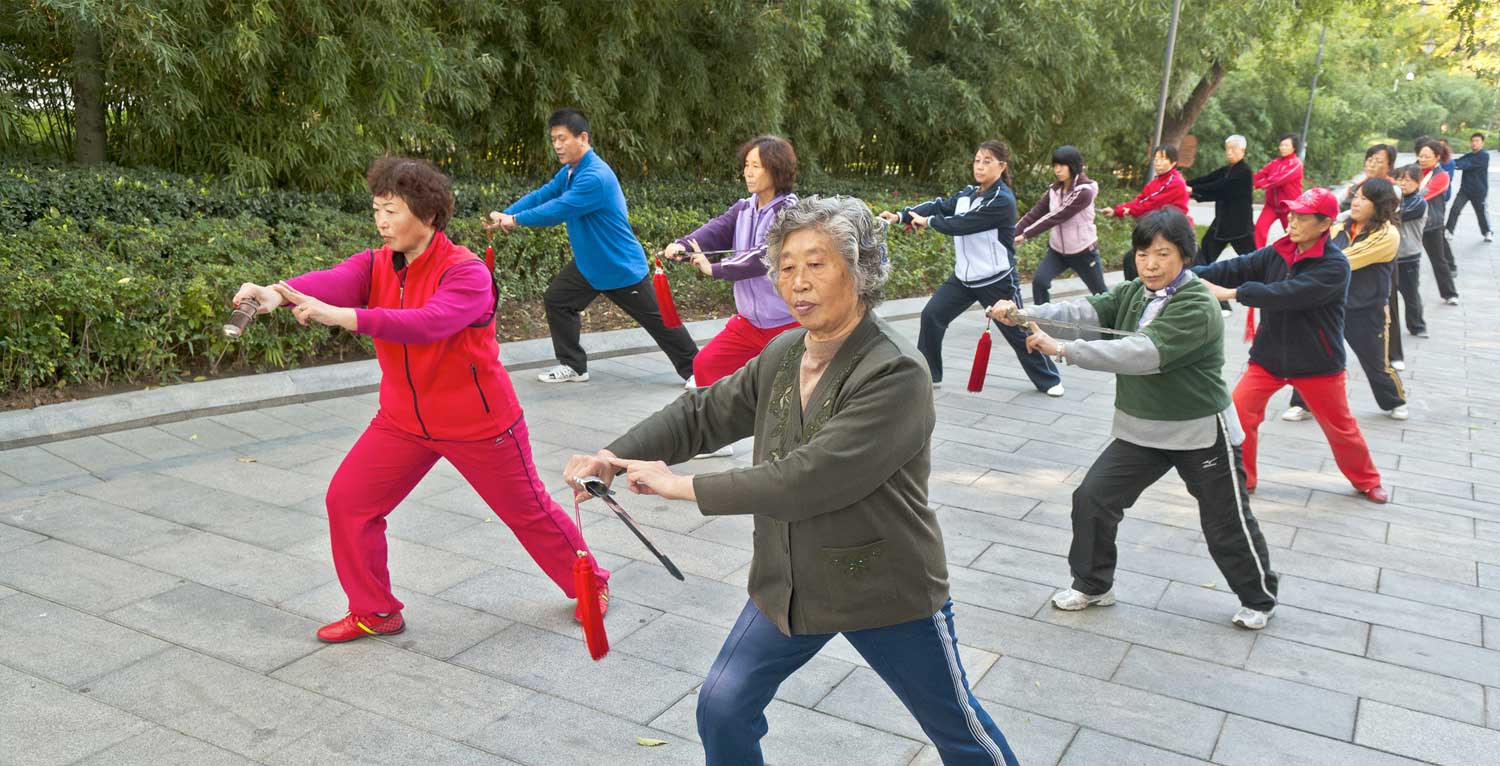
Community Social Infrastructure
The number of older adults living independently in China is expected to double by 2030. To enable aging in place, the Chinese government has intensified efforts to establish a more age-friendly social infrastructure. An extensive network of community/village recreation centers and schools for older adults has been built nationwide to provide various entertainment and cultural activities, although the distribution density of these facilities remains relatively low in rural areas. The government has also encouraged active aging by promoting volunteer activities.
Today, more than 50 percent of older Chinese adults, or around 100 million people, do not live with their offspring. The percentage is even higher in large and medium-sized cities at around 70 percent. The number of older adults living alone or with a spouse only is projected to exceed 200 million by 2030.
China is a leader among the upper middle-income countries in this study in providing community support for older adults. Following major policy guidelines introduced by the central government in 2013 to accelerate the development of the older-age care sector, a variety of pilot projects and models have been adopted at the local level to provide integrated community-based services, ranging from daily life care to emergency assistance. Public-private partnerships are more common in urban areas, while an innovative model centered on mutual assistance among older community members has been promoted in rural areas.
Accessibility of physical infrastructure remains an area with much room for improvement. While economic development has caused general livability to improve significantly in China, housing, outdoor space, and transportation have generally failed to catch up with the needs of an aging population.
Silver Age Action Initiative
In 2003, China introduced the Silver Age Action Initiative, whereby retired professionals are organized to volunteer in western and less-developed regions, utilizing their knowledge and experience to help local economic and social development. Over the past decade, the initiative has evolved significantly, now covering 31 provinces and including various city-to-city or urban-to-rural partnerships. Volunteer activities have expanded from the initial focus on public health and medical care to a broader scope including culture, education, and agriculture. As of the end of 2013, around 5 million older professionals nationwide had vol unteered and benefited around 300 million people, creating a total estimated value of more than USD 1.2 billion.
Productive Opportunity
The Chinese government has thus far missed the productive opportunity that the older labor force represents. As in other countries, older Chinese workers face barriers, including age discrimination by employers and lack of relevant skills. In contrast to its efforts to improve social infrastructure for older adults, the government has paid much less attention to providing training to improve their employability and to cultivating age-friendly workplaces. The lack of legal protection for the rights and interests of older adults who resume working post-retirement also inhibits this population from re-entering the labor force.
China has the lowest pensionable retirement age among countries in this study. The government’s recent efforts to raise the retirement age would help to extend older adults’ participation in the labor force, although it has been driven mainly by the pursuit of fiscal sustainability of the pension system rather than productivity growth. The retirement age for female employees in the public sector was raised in 2015, and the government is aiming to extend the retirement age for all urban residents as the next step, with the final proposal expected to come out in 2017.
“The mandatory retirement age in China is very low, compared with other countries, and extending the retirement age is critical for the country to prepare itself for the looming demographic change. Labor market reform, such as creating a flexible retirement system, is also needed to boost older adults’ economic participation.”
– Richard Jackson, President of Global Aging Institute
The labor force participation rate of older adults age 65 or older was 21 percent in 2010, higher than the OECD average of 12.6 percent, with significant variation between men and women and between rural and urban areas.
Source: OECD, China Health and Retirement Longitudinal Study
Employment Rate by Gender and Region (2011/2012)
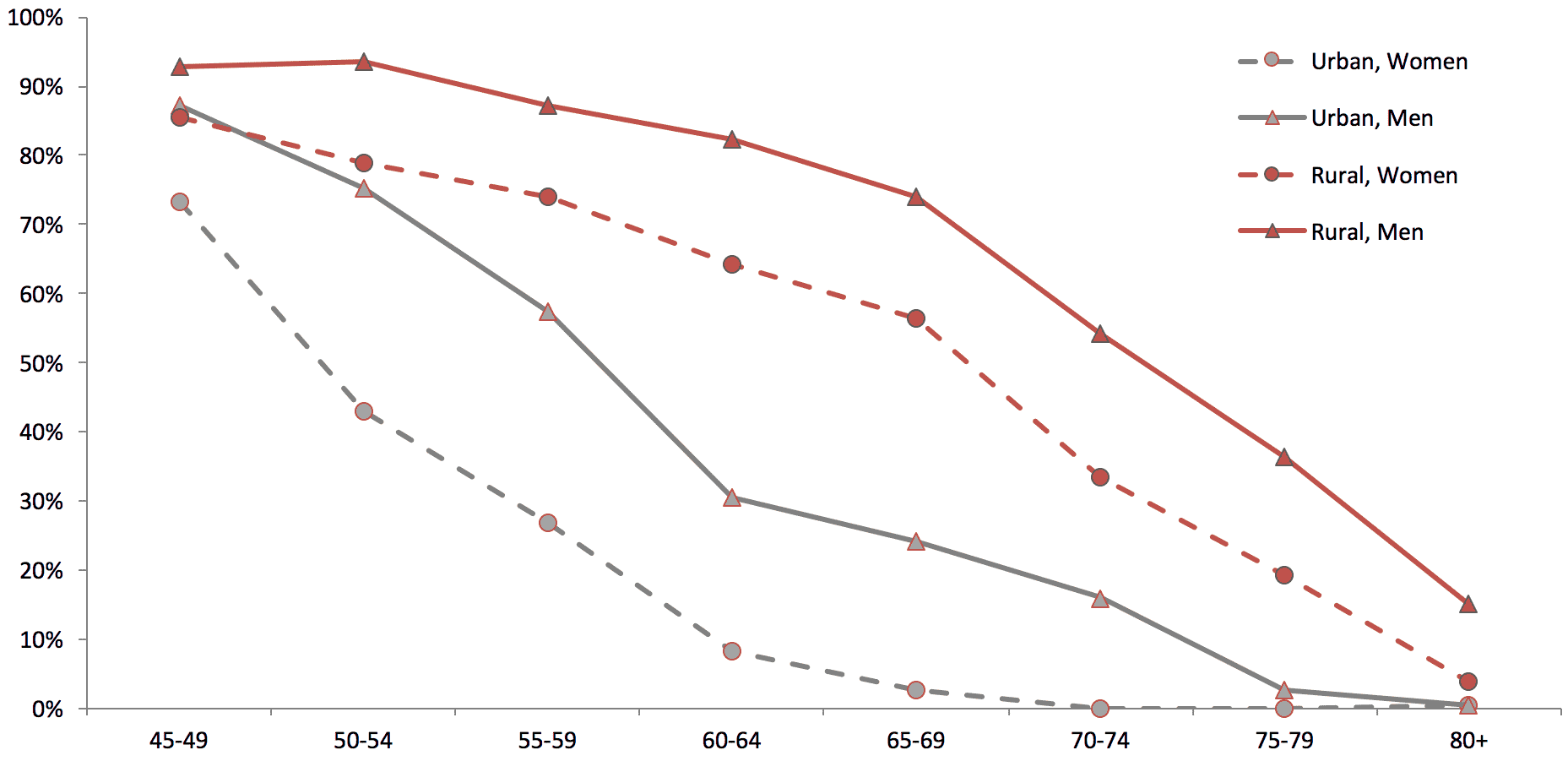

Technological Engagement
Actively incorporating digital technology into its competitiveness strategy, the Chinese government has seized on the opportunity to develop information and communication technology (ICT)-driven solutions to accommodate the needs of older adults. The central government highlighted the task of developing the smart care sector for older adults in its “Internet+” Action Plan launched in 2015, and is seeking to promote the use of online information platforms for older-age care and Internet-based portable devices in professional caregiving.
The central government’s promotion of ICT-driven solutions for older-age care has been met with a position response from local governments. Municipalities of major cities have pioneered efforts to embed the Internet of Things into community care services or to integrate the development of the ICT-driven older-age care sector into local industrialization plan
Beginning in July 2016, in the Shijingshan District of Beijing City, residents who are age 80 and older, disabled, or living alone are provided with free smart watches, which were developed by the Center for Modern Community and Management Promotion, a non-profit organization. Participants in the program can use the watches to order meals from community care centers. The devices can also easily position an older adult should he or she become disoriented.
However, the digital divide between older adults and the rest of the population remains a stumbling block to realizing the economic potential in old-age digital consumption. While older adults in China have limited access to digital skills training, the extensive network of public libraries represents a potential channel to offer ICT training sections for them.
Percentage of Households with One or More Computers
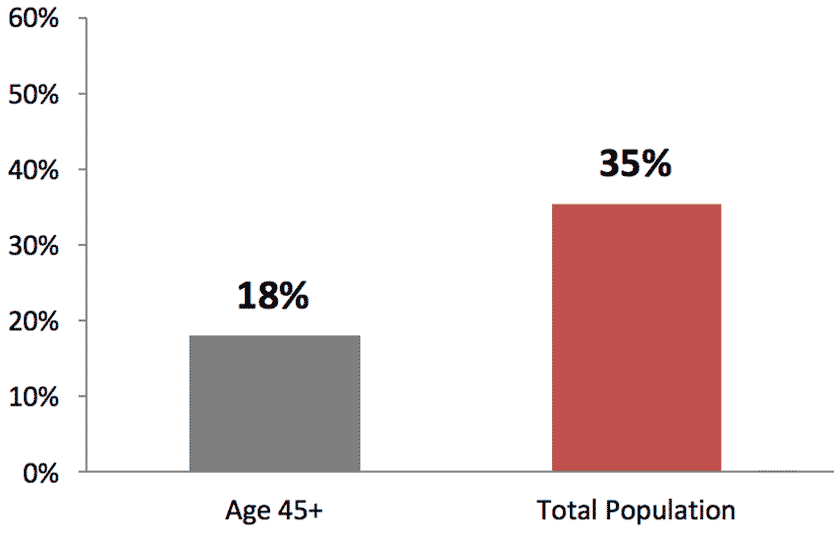
Smart Phone Users, Percentage of Population
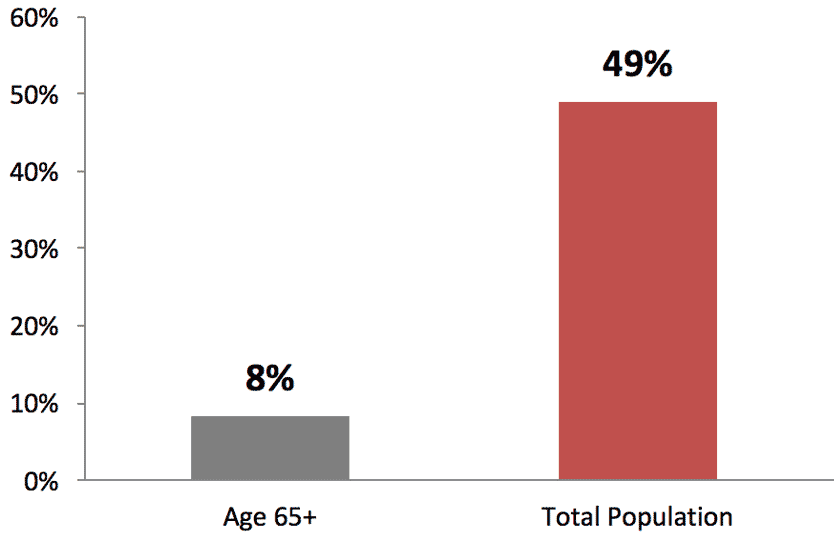
Internet Users, Percentage of Population
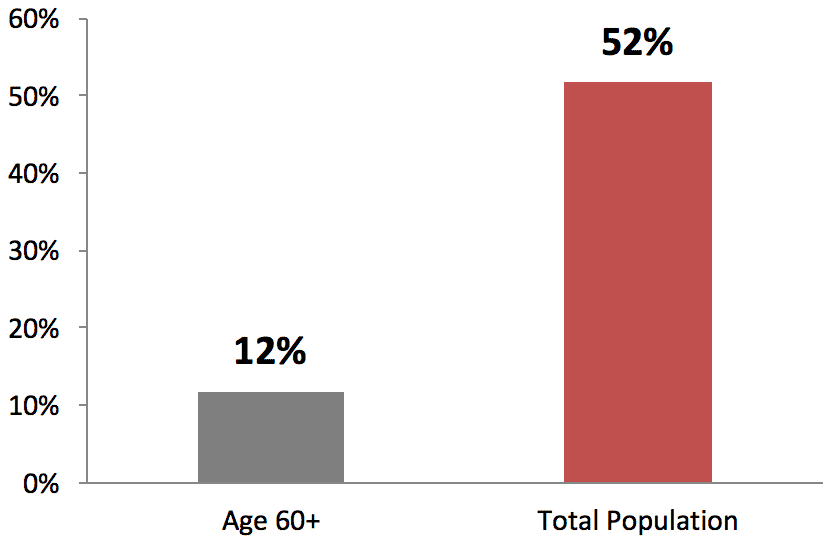
Source: Global Information Technology Report, OECD, eMarketer
Healthcare & Wellness
Improving healthcare and wellness of older adults is another priority on China’s aging policy agenda. Broadly, China has been undertaking a major reform of its healthcare system, including expanding the coverage of universal basic health insurance, increasing the function of primary care, and intensifying the focus on healthy lifestyle promotion across the society. Through the reform, the government is seeking to boost the health of the general population and to contribute to improved health in older adults for in the future.
China has the largest population of disabled older adults in the world. Nine percent of those aged 60 or older are fully disabled, and 24 percent need assistance in daily activities. The number of disabled older adults is projected to reach 9.7 million by 2050, a 260 percent increase from 2013.
As of 2015, the number of beds in long-term care facilities had more than doubled from the 2010 level to 6.69 million and reached 30.3 per thousand older adults.
Along with other developing countries, China is lagging behind industrialized countries in the provision of long-term care, but has stepped up efforts to expand institutional capacity and improve quality of care services. The government also recently started to pilot solutions to increase the affordability of long-term care, such as the inclusion of rehabilitation and care expenditures in health insurance. Like ICT-driven older-age care solutions, medical tourism is another area where the government sees economic potential in an aging society, with popular tourist destinations at the forefront of tapping into this market.
Tapping Economic Potential in Older-Age Medical Tourism
Hainan province, a major domestic tourism destination in China, has been an early mover on seizing the economic opportunity of older-age medical tourism. With the service sector accounting for more than half of its GDP, the provincial government has been promoting the “migratory bird” older-age care industry, providing rehabilitation facilities for older medical tourists. Similarly, Heilongjiang, a northeastern province that is traditionally dominated by heavy industries and possesses great forest and wetland resources, is seeking to incorporate the development of older-age medical tourism into its structural transformation efforts. In 2016, the central government introduced a series of preferential policies in order to accelerate the expansion of medical tourism capacity.